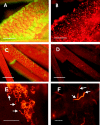Epiphytic cyanobacteria on Chara vulgaris are the main contributors to N(2) fixation in rice fields
- PMID: 15345425
- PMCID: PMC520917
- DOI: 10.1128/AEM.70.9.5391-5397.2004
Epiphytic cyanobacteria on Chara vulgaris are the main contributors to N(2) fixation in rice fields
Abstract
The distribution of nitrogenase activity in the rice-soil system and the possible contribution of epiphytic cyanobacteria on rice plants and other macrophytes to this activity were studied in two locations in the rice fields of Valencia, Spain, in two consecutive crop seasons. The largest proportion of photodependent N(2) fixation was associated with the macrophyte Chara vulgaris in both years and at both locations. The nitrogen fixation rate associated with Chara always represented more than 45% of the global nitrogenase activity measured in the rice field. The estimated average N(2) fixation rate associated with Chara was 27.53 kg of N ha(-1) crop(-1). The mean estimated N(2) fixation rates for the other parts of the system for all sampling periods were as follows: soil, 4.07 kg of N ha(-1) crop(-1); submerged parts of rice plants, 3.93 kg of N ha(-1) crop(-1); and roots, 0.28 kg of N ha(-1) crop(-1). Micrographic studies revealed the presence of epiphytic cyanobacteria on the surface of Chara. Three-dimensional reconstructions by confocal scanning laser microscopy revealed no cyanobacterial cells inside the Chara structures. Quantification of epiphytic cyanobacteria by image analysis revealed that cyanobacteria were more abundant in nodes than in internodes (on average, cyanobacteria covered 8.4% +/- 4.4% and 6.2% +/- 5.0% of the surface area in the nodes and internodes, respectively). Epiphytic cyanobacteria were also quantified by using a fluorometer. This made it possible to discriminate which algal groups were the source of chlorophyll a. Chlorophyll a measurements confirmed that cyanobacteria were more abundant in nodes than in internodes (on average, the chlorophyll a concentrations were 17.2 +/- 28.0 and 4.0 +/- 3.8 microg mg [dry weight] of Chara(-1) in the nodes and internodes, respectively). These results indicate that this macrophyte, which is usually considered a weed in the context of rice cultivation, may help maintain soil N fertility in the rice field ecosystem.
Figures






References
-
- Anand, V. K., G. Langer, and K. Anand. 1992. Epiphytic and associated algae of charophytes and their role as biological indicator. Indian J. Ecol. 19:1-4.
-
- Aziz, A., and Q. A. Ahmed. 1992. Occurrence and biomass of algae epiphytic on deepwater rice plants near Sonargaon, Bangladesh. Arch. Hydrobiol. 125:479-486.
-
- Blindow, I. 1992. Long- and short-term dynamics of submerged macrophytes in two shallow eutrophic lakes. Freshwater Biol. 28:15-27.
-
- Blindow, I., A. Hargeby, and G. Anderson. 2002. Seasonal changes of mechanisms maintaining clear water in a shallow lake with abundant Chara vegetation. Aquat. Bot. 72:315-334.
-
- Bold, H. C., and M. J. Wynne. 1985. Introduction to the algae. Prentice-Hall, Inc., Englewood Cliffs, N.J.
Publication types
MeSH terms
LinkOut - more resources
Full Text Sources
Research Materials

